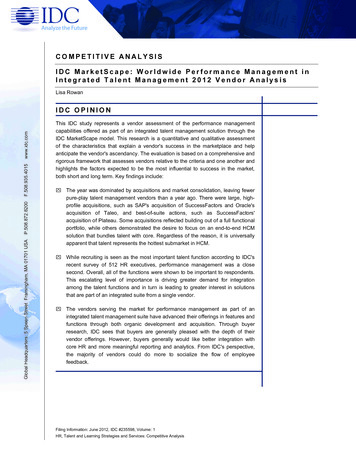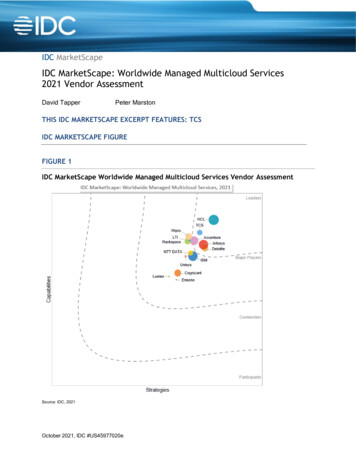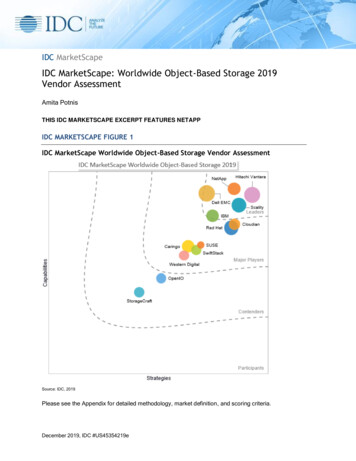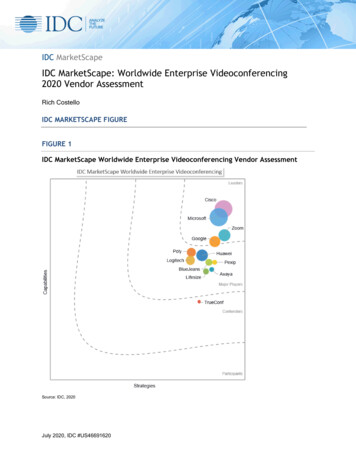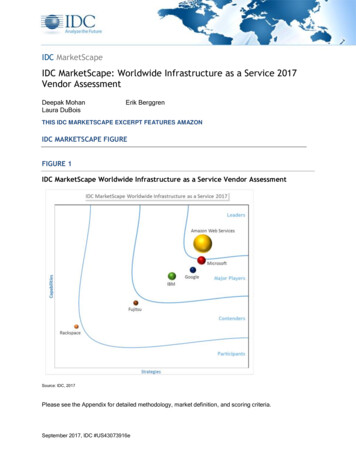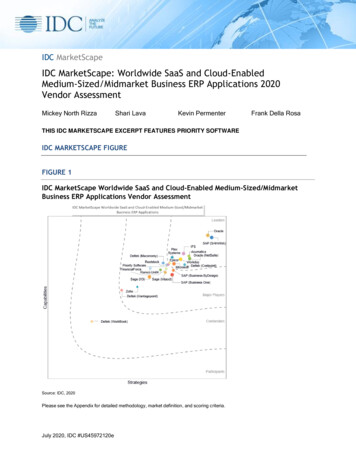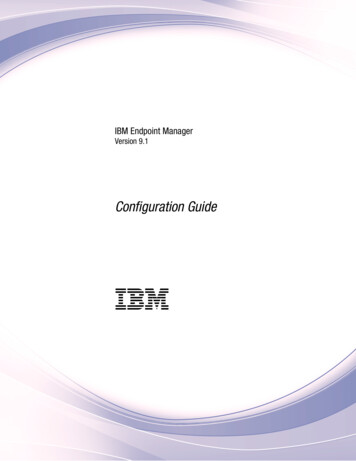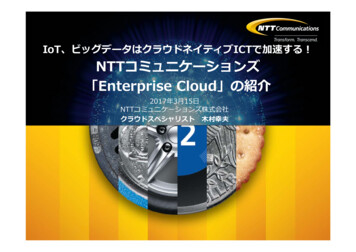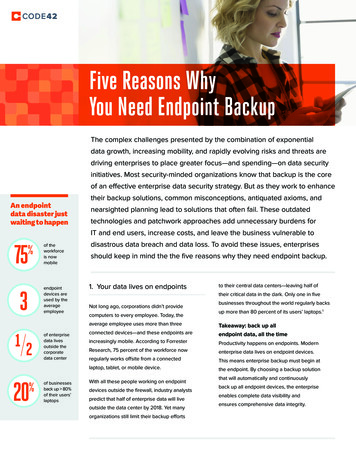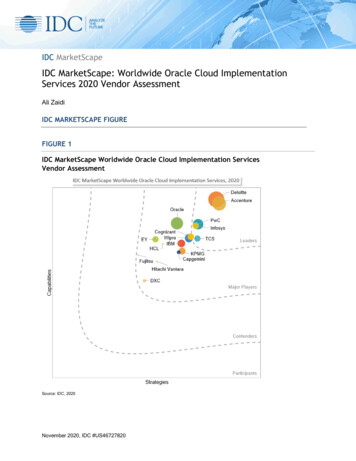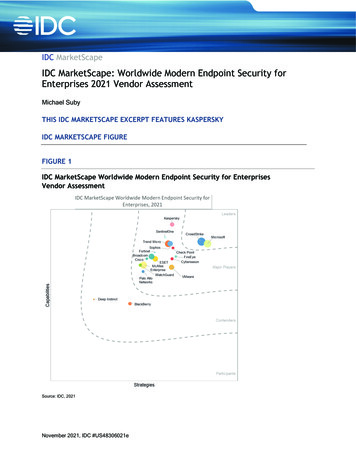
Transcription
IDC MarketScapeIDC MarketScape: Worldwide Modern Endpoint Security forEnterprises 2021 Vendor AssessmentMichael SubyTHIS IDC MARKETSCAPE EXCERPT FEATURES KASPERSKYIDC MARKETSCAPE FIGUREFIGURE 1IDC MarketScape Worldwide Modern Endpoint Security for EnterprisesVendor AssessmentSource: IDC, 2021November 2021, IDC #US48306021e
IN THIS EXCERPTThe content for this excerpt was taken directly from IDC MarketScape: Worldwide Modern EndpointSecurity for Enterprises 2021 Vendor Assessment (Doc # US48306021). All or parts of the followingsections are included in this excerpt: IDC Opinion, IDC MarketScape Vendor Inclusion Criteria,Essential Guidance, Vendor Summary Profile, Appendix and Learn More. Also included is Figure 1.Please see the Appendix for detailed methodology, market definition, and scoring criteria.IDC OPINIONThe criticality of effective endpoint security has never been greater for enterprises. A principal reasonis enterprises' evolving IT footprint. Spurred by the COVID-19 pandemic, millions of office workerschanged locations from onsite to work from home (WFH). While workers are gradually returning to theoffice, the workplace landscape for many organizations is unlikely to return to its pre-pandemic state.In addition, the usage of cloud applications surged during the pandemic as business leaders soughtflexibility to support their immediate needs and to better compete in a digitally transformed future.This dual shift of workers and applications to off premises has been a gift to threat actors. Theexploitability of personal computers (PCs) of WFH employees increased. In addition to being situatedoutside office-based perimeter defenses, these devices were now on a full-time basis connectingthrough unmanaged home networks and with increasing potential, used for nonbusiness purposes andby other family members. The viability for threat actors to infect remote PCs, in essence, multiplied.And since users of these devices required access to cloud-based applications (custom and softwareas a service) and on-premises applications through a VPN to remain productive, the attractiveness ofPCs as targets rose. Moreover, as worker remoteness increased along with access to both cloud andon-premises applications, business networks became flatter. Legacy approaches to use networksegmentation as a security mechanism became less effective. Also a benefit to threat actors, theirlateral movement from the first infected PCs to other PCs and connected IT systems encounteredfewer barriers.Not only have threat actors intensified their focus on endpoints, but they have also advanced theirtradecraft. A decade ago, signature-based antivirus software was considered an adequate defense inidentifying and removing malware from end-users' devices. Times have radically changed. Threatactors no longer rely exclusively on dropping malware onto devices to carry out their attacks. Instead,they are more apt to manipulate legitimate software programs, tools, and files (i.e., living off the landattacks). Subsequently, identifying behaviors of malicious intent has become a requirement inmounting an adequate defense.Identifying malicious behaviors, however, is no simple task. The varied, wide ranging, and complexnature of what end-user devices (PCs and smartphones) are equipped to do blurs the distinctionbetween malicious and legitimate behaviors. In addition, threat actors will orchestrate a series ofactions, each seemingly benign, to further disguise their presence. Assembling the trail of relatedactions has become essential in uncovering active attacks and then responding with speed andprecision to blunt them.Building up endpoint security is crucial. Modern endpoint security (MES) products, the combination ofendpoint protection platforms (EPPs) for deterministic prevention and endpoint detection and response(EDR) for post-compromise reaction, are the latest evolution in endpoint security designed to combat 2021 IDC#US48306021e2
threats aimed at endpoints. It is confirmed through IDC research that the demand for modern endpointsecurity is on the rise.A modern endpoint security product, however, is not an island. Rather, it is a component in aconstellation of complementary security technologies and operations that function together to fortifythe security posture of endpoints and the resiliency of business functions. Given this more holistic viewof modern endpoint security, enterprises should not limit their assessment of the independent merits ofmodern endpoint security products. They should also examine integration and workflow streamliningwith and across other technologies that fortify security and enhance security and IT operations. A list ofthese technologies includes but are not limited to hardware-based device integrity checks andrestoration, endpoint/IT hygiene management, file and data backup and recovery, and the evolution ofEDR to eXtended Detection and Response (XDR).IDC MARKETSCAPE VENDOR INCLUSION CRITERIAParticipating vendors met the following criteria: From a single endpoint software agent, the vendor's modern endpoint security productsupports both endpoint protection platform and endpoint detection and response. End-user personal computing device platforms supported by the modern endpoint securityproduct must, at minimum, include the latest versions of Windows and macOS. Vendor began selling modern endpoint security products to customers from January 2019 orearlier. Sales to commercial and governmental customers of EPP (also referred to as antivirus ornext-generation antivirus), EDR, and modern endpoint security products must, at minimum,totaled 30 million (following generally accepted accounting principles [GAAP]) in calendaryear 2020. At year-end 2020, the vendor's percentage of customers with 2,500 or more protectedendpoints exceeded 5%.ADVICE FOR TECHNOLOGY BUYERSJust as the threat landscape has evolved so too has the endpoint security market.As the threat landscape has evolved with intensified focus on compromising endpoint devices, so toohas the landscape of modern endpoint security vendors included in this IDC MarketScape. With this,enterprise endpoint security buyers have greater choice and opportunity to select a vendor that is bestaligned with their circumstances and requirements. Our overarching advice is to evaluate vendors fromthe perspective of strategic fit. Selecting a vendor and its MES product is not only for combating thethreats of today as they will be different tomorrow. Rather, the selection should be made from a longterm perspective on whether the vendor can adapt to the threats of the future while also reducing thecost and complexity of security operations.More tactically, IDC offers this advice to enterprise MES buyers: Focus first on MES fundamentals: 2021 IDCProtection efficacy. IDC buyer analysis revealed enterprises' top consideration in choosinga MES vendor is its research into never-before-seen threats and attack tactics. But buyers#US48306021e3
are not content with just research, they want results. There is no better result thanautomatically and deterministically blocking new forms of attacks. Independentevaluations on protection efficacy are useful guides in this regard but are not the panacea.IDC recommends conducting proof of concepts (POCs). We further recommend that EPPPOCs should become a routine activity. With existing vendors evolving their EPPcapabilities and new vendors emerging with "next generation" approaches, comparativeanalysis in your environment is the best litmus test. Avoid the trap of being the enterprisethat started its search for a more effective MES product after it suffered a serious securityincident. EDR automation. Second on the list of buyers' vendor selection criteria is incidentinvestigation speed and ease. The unfortunate reality is some attacks will evade theimmediate preventions of EPP and establish a footprint on endpoints. Security teams needto be prepared. But just having EDR functionality is not enough, human engagement isrequired. Concentrating human engagement more on decision making and less oninvestigatory processes is vital in lessening threat actors' dwell time and the time requiredof your security personnel. Therefore, automation is essential and is present in variousforms, such as assembling and cross-correlating relevant data, visualizing attacksequence, devising risk-rated responses, and executing on the chosen response(s). Inaddition, enterprises cited automated threat hunting as an important factor in considering aMES vendor. Conducting a proof of concept is the most effective means for evaluating thevendor's level of automation and usability fit with your security personnel. Device support. MES products can only deliver EPP and EDR capabilities on endpointdevice types and operating systems (OS) that their software agents support. Obviously,you will want to confirm support for the device types and OS platforms that are in yourenvironment. All vendors in this IDC MarketScape support recent OS versions of Windowsand Mac. But Windows and Mac PCs are not the only device types attacked. Mobiledevices, physical and virtual servers, and cloud workloads are also targeted. Whilevendors' datasheets list supported device types and OSs, IDC recommends diggingdeeper into feature parity and feature distinction to ensure the vendor's product isadequately equipped for all of your devices and provides unified management. Examine cross-function integration. Endpoint security and endpoint management functions areintertwined. Unpatched and out-of-date software applications and OS versions are targets ofexploitation by threat actors. When exploited, EPP and EDP become the next two layers ofcompensating security. Quite likely, your organization has a dedicated patch managementsolution in place. If that is the case, cross-vendor integrations should be examined for timesaving enhancements in workflows and acceleration in risk reduction. Alternatively, anincreasing number of vendors offer patch management as part of their product suite. This toocan be a suitable option if the feature set meets the varied needs of your IT estate. In addition,patch management is one of several functions that reduce an endpoint's attack surface and,consequently, exploitability. Other functions include device control, host firewall management,vulnerability assessment, micro-segmentation, and application blacklisting, whitelisting, andprocess-level allow listing. In your consideration of MES vendors, comparing their collection ofattack surface reduction capabilities with those of dedicated products may reveal an effectiveand possibly a more affordable approach to strengthening your security posture. Evaluate XDR frameworks. Reaching a complete and speedy understanding of attacksaffecting endpoints may require more than telemetry gathered from endpoints running a MESsoftware agent. Telemetry from other sources (e.g., network sensors, perimeter defenses,email and web gateways, cloud access security brokers, and identity management services)can bring in beneficial context. Many of these sources can also be control points for applying 2021 IDC#US48306021e4
attack-mitigating responses and in refining security policies. An oversimplified description, thisis the realm of eXtended Detection and Response. Nearly all vendors in this IDC MarketScapehave an XDR framework that encompasses their non-endpoint security product portfolios,ecosystem partners, or a combination of both. As part of your assessment of MES products,evaluate the vendor's current state of XDR, future developments, and incremental securityvalue and what a transition from EDR to XDR will entail (e.g., additional cost, technologyupgrades, and staff training and augmentation). Question ransomware defenses and recovery options. The consequences of ransomwareincidents are a top-of-mind concern for business leaders, and for good reason. According toIDC's July 2021 Future Enterprise Resiliency and Spending Survey, Wave 6, 75% of ITdecision makers with organizations that experienced one or more ransomware incidents in thepast 12 months indicated that significant extra resources beyond what internal staff handledwere required to rectify. Ransomware, like other forms of malware, frequently enter businessnetworks through endpoint devices. Subsequently, endpoint security products, like MES, are avital line of defense. But just as ransomware has evolved to evade detection, and ultimately,increased the likelihood of payment and amount of ransom payment, MES products must alsoevolve to detect ransomware and prevent its execution (e.g., data exfiltration and fileencryption) and propagation to other endpoints and critical systems. IDC recommends thatyou query MES vendors about their ransomware defenses and incident recovery options forreturning affected files and endpoint configurations (e.g., changes to registry keys) to theirprevious known good state. As you do, assess these capabilities within the context of youroverall business cyber-resiliency plans. Gain perspective on incorporation of built-in device security capabilities. Worth repeating,threat actors will evolve how they conduct attacks. They will continuously probe for newavenues to enter and takeover endpoints. While not yet mainstream, attackers compromisingthe device's firmware is a possibility. Rather than react to this possibility once it becomesreality, ask MES vendors about their approach to confirming firmware integrity and restoration.Also ask about leveraging the device's chip-based processing features in conducting oraugmenting MES functions. Eventually, the measuring stick for endpoint security solutions willentail the collaboration of built-in device security with overlay on-device security softwareaugmented with cloud-powered features. To make security-maximized decisions on deviceand MES product purchases, ask MES vendors about their current and planned approaches toleveraging built-in device security features. Consider managed services options. Although MES vendors have and will continue toautomate and simplify the use of EDR, experienced security professionals are needed toproduce maximum return on EDR's capabilities. IDC recommends that you consider themanaged service options offered by MES vendors and/or their channel partners. As serviceneeds vary by level of engagement (e.g., from on-demand collaboration to around-the-clockoutsourcing) and tasks performed (e.g., threat monitoring, threat hunting, and threatresponse), seek a managed services arrangement that best aligns with your current needsand budget but is also flexible to adjust for changing circumstances.VENDOR SUMMARY PROFILESThis section briefly explains IDC's key observations resulting in a vendor's position in the IDCMarketScape. While every vendor is evaluated against each of the criteria outlined in the Appendix,the description here provides a summary of each vendor's strengths and challenges. 2021 IDC#US48306021e5
KasperskyKaspersky is positioned in the Major Players category in the 2021 IDC MarketScape for modernendpoint security for enterprises.A prominent vendor operating worldwide, Kaspersky has expanded its security product suite beyondits endpoint security roots. Its current product suite includes inline security for the common threatvectors of email and web. The company also offers security products for ICS, IoT, and networkattached storage and offers fraud prevention. Kaspersky is not solely products, it has an expandingsuite of services spanning assessment, training, threat intelligence, incident response, and detectionand response. Focused on cross-product and service integration and reuse of a common technologybase, Kaspersky's approach to new product introduction, feature expansion, and service processdesign and staffing is from within rather than through acquisitions.StrengthsCapabilities of Kaspersky's modern endpoint security product are very competitive with no materialdeficiencies.The company is among the most tested for EPP capabilities.With its expanding and internally developed product suite, the company is well positioned to offerenterprise customers a natively integrated cross-product solution.Platform support is expansive and includes cloud workloads. On personal computing device, the onlygap is lack of support for Chromebooks. However, Kaspersky is not alone, only a small subset of MESvendors currently support Chromebooks.Kaspersky offers a range of endpoint security products distinguished by different feature sets and notall meeting IDC's strict definition of MES. Nevertheless, with double-digit annual customer growth withits non-MES products, Kaspersky is building a strong pipeline of upgradable customers to its MESproducts.Representing an additional and real-time source of threat intelligence, Kaspersky is a major provider ofdigital life protection products for consumers.Kaspersky leverages its profitable operations to fuel product expansion and enhancement.ChallengesAs enterprises look to advance from EDR and XDR, Kaspersky is slightly behind other vendors inthird-party integrations in SOAR and identity. Also some of the larger security companies offer a cloudsecurity gateway (i.e., cloud access security broker) as an additional source of context data and as anadditional policy control point. Kaspersky does not have a cloud security gateway in its product suite.A subset of vendors utilizes Intel's Threat Detection Technology for firmware integrity monitoring.Kaspersky contends its technology delivers similar if not better security benefits.With a customer footprint concentrated in EMEA, LATAM, and APAC, Kaspersky is at a disadvantagewithout a greater U.S. presence. 2021 IDC#US48306021e6
Consider Kaspersky WhenA highly competitive MES product with no material deficiencies, Kaspersky is worthy of considerationfor EPP replacement first and second as part of a MES product strategy. Enterprises with a vendorreduction objective, Kaspersky's integrated product suite adds another reason for consideration. Inevaluating Kaspersky as a long-term XDR solution, assess the company's ecosystem fit for yourneeds.APPENDIXReading an IDC MarketScape GraphFor the purposes of this analysis, IDC divided potential key measures for success into two primarycategories: capabilities and strategies.Positioning on the y-axis reflects the vendor's current capabilities and menu of services and how wellaligned the vendor is to customer needs. The capabilities category focuses on the capabilities of thecompany and product today, here and now. Under this category, IDC analysts will look at how well avendor is building/delivering capabilities that enable it to execute its chosen strategy in the market.Positioning on the x-axis, or strategies axis, indicates how well the vendor's future strategy aligns withwhat customers will require in three to five years. The strategies category focuses on high-leveldecisions and underlying assumptions about offerings, customer segments, and business and go-tomarket plans for the next three to five years.The size of the individual vendor markers in the IDC MarketScape represents the market share of eachindividual vendor within the specific market segment being assessed.IDC MarketScape MethodologyIDC MarketScape criteria selection, weightings, and vendor scores represent well-researched IDCjudgment about the market and specific vendors. IDC analysts tailor the range of standardcharacteristics by which vendors are measured through structured discussions, surveys, andinterviews with market leaders, participants, and end users. Market weightings are based on userinterviews, buyer surveys, and the input of IDC experts in each market. IDC analysts base individualvendor scores, and ultimately vendor positions on the IDC MarketScape, on detailed surveys andinterviews with the vendors, publicly available information, and end-user experiences in an effort toprovide an accurate and consistent assessment of each vendor's characteristics, behavior, andcapability.Market DefinitionModern endpoint security products protect personal computing devices (PCDs, such as workstationsand laptops) from cyberattacks through the detection of malicious code and behaviors present oroperating within the PCD and then facilitate a counteracting response (e.g., block, remove, or isolate).Modern endpoint security products contain two detect and response mechanisms differentiated basedon elapsed time and human involvement. Endpoint protection platforms (EPP) reach detection verdictsand initiate responses in real time and autonomously (i.e., without human involvement). Endpointdetection and response (EDR) is a second stage of detection and response for cyberattacks that haveevaded EPP detection. With EDR, the time to reach detection verdicts and initiate responses can spanminutes to days. How fast the cyberattack unfolds, its sequence of steps, and its sophistication and 2021 IDC#US48306021e7
uniqueness are factors that affect the elapsed time in detection and response. Automation andpredefined workflows assist in reducing the elapsed time. Security analysts (humans) are typicallyinvolved, at minimum, to confirm detection and/or authorize response.LEARN MORERelated Research Top Technology Integration Opportunities for Unified Endpoint Management (IDC#US48266821, September 2021) Market Analysis Perspective: Worldwide Tier 2 SOC Analytics, 2021 — Where the Puck IsGoing (IDC #US47394921, September 2021) Market Analysis Perspective: Worldwide Corporate Endpoint Security, 2021 (IDC#US48208121, September 2021) IDC's 2021 Ransomware Study: Where You Are Matters! (IDC #US48093721, July 2021)Which Criteria Rank Highest in the Evaluation of Modern Endpoint Security Products? (IDC#US48053021, July 2021) Worldwide Corporate Endpoint Security Forecast, 2021–2025: On a Higher Growth Trajectory(IDC #US47957021, June 2021) Worldwide Corporate Endpoint Security Market Shares, 2020: Pandemic and ExpandingFunctionality Propelled Market Growth (IDC #US47768021, June 2021) Insights from IDC's EDR and XDR 2020 Survey: Operational Challenges and Initiatives AreAbundant (IDC #US47357921, January 2021)SynopsisThis IDC study represents a vendor assessment of modern endpoint security for enterprises throughthe IDC MarketScape model."Modern endpoint security products have evolved from point solutions to multifunction securityplatforms," according to Michael Suby, research vice president, Security and Trust at IDC. "Theprincipal reason for this evolution is time. Threat actors are finding and exploiting vulnerabilities andweakness in security defenses at a faster pace. Conversely, enterprise security professionals havezero spare time. They must operate faster and more efficiently across a broader IT estate if they everhope to change circumstances from primarily reacting to threats to getting ahead of threats. Thetrajectory of modern endpoint security products is reassuring. First by integrating endpoint protectionand endpoint detection and response together, vendors are weaving in additional security and IThygiene functionality into a cohesive risk reduction and breach avoidance platform." 2021 IDC#US48306021e8
About IDCInternational Data Corporation (IDC) is the premier global provider of market intelligence, advisoryservices, and events for the information technology, telecommunications and consumer technologymarkets. IDC helps IT professionals, business executives, and the investment community make factbased decisions on technology purchases and business strategy. More than 1,100 IDC analystsprovide global, regional, and local expertise on technology and industry opportunities and trends inover 110 countries worldwide. For 50 years, IDC has provided strategic insights to help our clientsachieve their key business objectives. IDC is a subsidiary of IDG, the world's leading technologymedia, research, and events company.Global Headquarters140 Kendrick StreetBuilding BNeedham, MA 02494USA508.872.8200Twitter: @IDCblogs.idc.comwww.idc.comCopyright and Trademark NoticeThis IDC research document was published as part of an IDC continuous intelligence service, providing writtenresearch, analyst interactions, telebriefings, and conferences. Visit www.idc.com to learn more about IDCsubscription and consulting services. To view a list of IDC offices worldwide, visit www.idc.com/offices. Pleasecontact the IDC Hotline at 800.343.4952, ext. 7988 (or 1.508.988.7988) or sales@idc.com for information onapplying the price of this document toward the purchase of an IDC service or for information on additional copiesor web rights. IDC and IDC MarketScape are trademarks of International Data Group, Inc.Copyright 2021 IDC. Reproduction is forbidden unless authorized. All rights reserved.
restoration, endpoint/IT hygiene management, file and data backup and recovery, and the evolution of EDR to eXtended Detection and Response (XDR). IDC MARKETSCAPE VENDOR INCLUSION CRITERIA Participating vendors met the following criteria: From a single endpoint software agent, the vendor's modern endpoint security product
